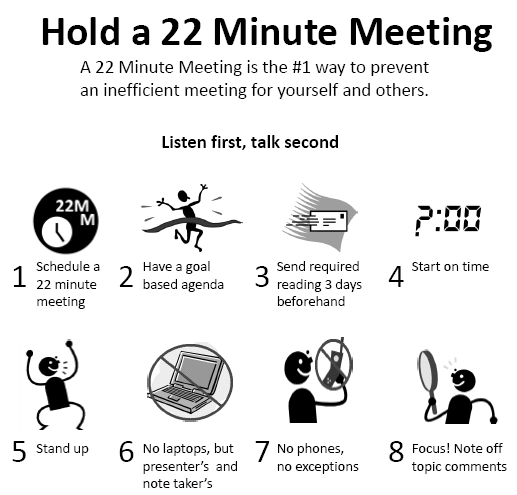The 22 minute meeting (updated)
(Updated: Now with Nicole Steinbok ignite video at bottom)
No one likes meetings and for good reason. In most meetings, most of the time, most people think most of what goes on is a waste of time. So what if you took out all of the stupid, wasteful stuff and left only the useful parts?
Enter the 22 minute meeting. This is an idea from Nicole Steinbok, and she presented it at Seattle Ignite 9. When I saw her speak at Microsoft a few months ago, she gave one of the best short talks I’ve ever seen and I told her to do it at Ignite. Glad I did.
Here’s the poster from her talk (which you can use):

I couldn’t find a write up of the core points, so here’s my take on her ideas from what I remember from her talk. All credit should go her way:
- Schedule a 22 minute meeting – Who decided meetings should be 30 or 60 minutes? What data is this based on? None. 30 and 60 minute meetings leave no time to get between meetings, and assumes, on average, people need an hour to sort things out. Certainly not all meetings can be run in 22 minutes, but many can, so we’d all be better off if the default time were small, not large.
- Have a goal based agenda – Having an agenda at all would be a plus in most meetings. Writing it on the whiteboard, earns double pluses, since then everyone has a constant reminder of what the meeting is supposed to achieve.
- Send required readings 3 days beforehand – The burden is on the organizer to make this small enough that people actually do it. Never ever allow a meeting to be “lets all read the documents together and penalize anyone diligent enough to do their homework”. (note: I think 24 hours is plenty). Remember some great companies, like Amazon, make reading central to how decisions are made.
- Start on time – How often does this happen? Almost never. Part of the problem is Outlook and all schedule programs don’t have space between meetings. By 2pm there is a day’s worth of meeting time debt. 22 minutes ensures plenty of travel/buffer time between meetings.
- Stand up – Reminds everyone the goal isn’t to elaborate or be supplemental (See Scrum standing meetings). Make your point, make your requests, or keep quiet. If there is a disagreement, say so, but handle resolving it outside of the meeting.
- No laptops, but presenters and note takers. If you’re promised 22 minutes, and it’s all good stuff, you don’t need a secondary thing to be doing while you pretend to be listening. One person taking notes, and one person presenting if necessary.
- No phones, no exceptions – see above.
- Focus! Note off topic comments. If you have an agenda, someone has to police it and this burden is on whoever called the meeting. Tangents are ok, provided they are short. The meeting organizer has to table tangents and arguments that go too far from the agenda.
- Send notes ASAP – With 22 minutes, there should be time, post meeting, for the organizer to send out notes and action items before the next meeting begins.
What do you think?
If you like the idea, help it spread. Nicole started a facebook group and a poster you can download (PDF). Pass it on.
UPDATED: Here’s Nicole’s excellent Ignite talk.
